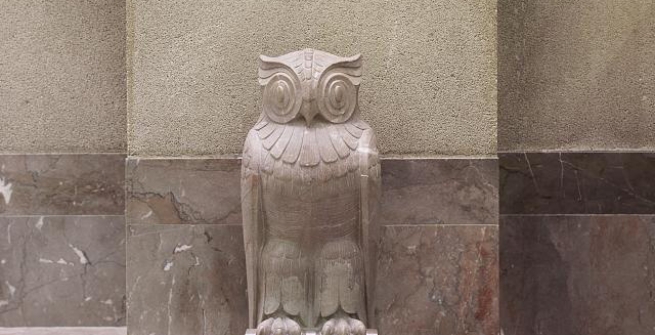The doors of wisdom are never shut.—Benjamin Franklin
The classic icon of wisdom, the owl, is found in several places around the original Bertram Goodhue Library building. These owls are not hidden, but they may not be obvious to the casual visitor.
Designed by sculptor Lee Lawrie, a long-time collaborator with the library’s architect, Bertram Goodhue, two sets of Lawrie’s limestone owls are found directly under the iron balconies on the east and west corners of the Fifth Street side of the Goodhue building. They are part of the mezzanine level (not accessible to the public.) One balcony bears the inscription In Libris Libertas (In books is [found] liberty) and the other, In Opera Gaudium (In work is joy.)
library, both accessed from the Fifth Street side.

The third owl is an elegant metalwork on the gates of the Hope Street tunnel.

The theme of Los Angeles’s Central Library, The Light of Learning, is illuminated inside and out by torches, sconces, chandeliers, and other references to light and learning and wisdom, like owls and serpents. One letter, in the correspondence between architect Bertram Goodhue and iconographer Hartley Burr Alexander, defines this theme as “Light and learning are associated together by an impulse so natural that it pervades the great literature of the world. Knowledge is imagined as a lamp, wisdom as a guiding star, and the conscious tradition of mankind as a torch passed from generation to generation.”
Of special interest is Lawrie's repeated use of the owl motif. One of the most beautiful is the metalwork owl in the John Adams Building of the Library of Congress in Washington D.C., which adorns the door to the fifth floor’s center reading room. Called “the owl of wisdom,” it is a prime example of the 1930s Art Deco style. In addition, a sculpted stone owl of Lawrie’s is also inside the building. The John Adams Building is renowned for its exquisite doors, which are another artwork of this famed sculptor.

Adams Building, Washington, D.C., considered a masterful art deco design. Photo from Library of Congress
It is not uncommon to have symbols of owls in libraries, as their anecdotal association with wisdom is universal and mythic. In ancient Greece, the owl was a guardian of the Acropolis, both the fortified citadel and sacred sanctuary site of Athena, the patron saint of Athens.
Many images of Athena show the fabled owl sitting on her “blind side” to enable her to see “the whole truth,” part of the legacy and myth that made both Athena, and the owl, symbols of a higher wisdom and strategy. Many think that the library's Statue of Civilization in the foyer leading to the Grand Rotunda bears a striking resemblance to Athena. Athena is also known as a source of reason, intelligent activity, arts, and literature, primary functions of our modern-day library.
Please join us for a docent-led tour of the Central Library.
Story by Diana Rosen.All photos from the Los Angeles Public Library Photo Collection, unless otherwise credited.



